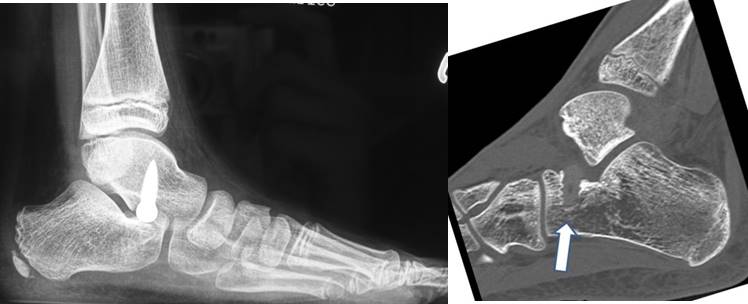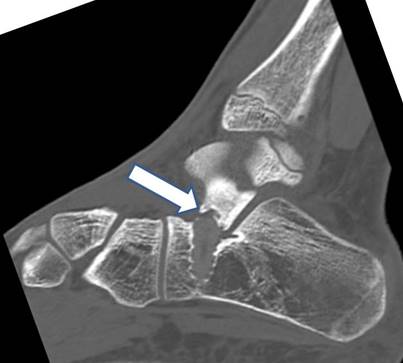Flat foot in children: surgical procedures
Surgical procedures for the correction of flat foot are divided into:
• Arthrorisis or arthroeresis (calcaneo-stop, endorthesis, etc.)
• Osteotomies
• Arthrodesis (joint fusion)
Arthroeresis is used in the growing child. Osteotomies and arthrodesis are used for flat foot after skeletal maturity.
Arthrodesis should be reserved for severe cases and generally not for flexible flat feet of the child/adolescent without underlying pathologies.
The osteotomy of the calcaneum, often associated with procedures on the soft tissues, is more demanding than the arthroeresis but provide excellent results in the short and long term if carried out with the right indications.
Arthroeresis (calcaneo-stop, endorthesis, etc.) for flat foot correction in children
Arthroeresis (calcaneo-stop, etc.) for flat foot is a relatively simple procedure
• The surgical wound is very small
• An implant (screw, spacer, etc.) is applied from a lateral access (just below and anterior to the lateral malleolus)
• The screw (or implant) changes the relationship between talus and calcaneus (the two bones of the rear foot). A stop is provided (for this the term calcaneo-stop is used) that limits the excessive inclination of the calcaneus. The implants would provide also a “proprioceptive” effect that is, stimulation of the nerve fibers present at this level.
• The functional recovery is quite rapid: generally the patient is allowed to walk immediately;
• Accessory surgical times (lengthening of the Achilles tendon, medial tensioning, accessory scaphoid resection, etc.) may be associated, if necessary.
LOCATION OF THE IMPLANT
The implant for flat foot arthroeresis surgery can be inserted:
• in the sinus of the tarsus (endorthesis)
• screwed into the calcaneum (calcaneo stop)
• screwed into the talus (calcaneo stop).
In general, main risk of endorthesis is that the implant can move out from the required site (with consequent loss of correction). Implants that are screwed into the bone generally do not have this risk.
MATERIAL OF THE IMPLANT
We distinguish:
• resorbable materials
• non resorbable materials.
Each has its own advantages and disadvantages. For example, the reabsorbable implant has the advantage of not requiring removal in most cases but can in some cases be resorbed early with consequent loss of correction.
The non-absorbable metal implants generally have superior mechanical properties, but generally need to be removed.

WHICH TECHNIQUE OF ARTHROERESIS IS SUPERIOR?
The possible types of arthroeresis for flat foot are used according to the personal preference and experience of the surgeon. There is not a procedure that is definitively superior to the other.
AGE FOR CALCANEO STOP/ARTHROERESIS SURGERY FOR FLAT FOOT
Generally, these procedures are indicated and have the best results between 9 and 12 years.
Simplifying, during the growth of the foot, its morphology is modified by the intervention; with growth, the structures adapt to the new situation and the presence of the implant is no longer necessary; therefore the screw can be removed or reabsorbed.
This range of age is not rigid. For example, some children exhibit early skeletal (and foot) growth and require earlier correction. The procedure can sometimes be performed even in older patients if the flatfoot has remained flexible.
OUR PREFERENCE
We generally use a metal screw inserted in the talus, not absorbable.
The results of arthroeresis/calcaneo stop surgery for flat foot.
Most of the authors (and this is our own experience) report in children with symptomatic flat foot good results in terms of satisfaction, quality of life, radiographic correction and return to sport.
COMPLICATIONS
A rate of complications between 3.5 and 19.3% has been reported for procedures of arthroeresis.
The main complications described are:
• Surgical issues (poor implant placement, hyper/hypocorrection, implant extrusion, wrong implant size)
• material problems (breakage, degradation)
• biological problems (synovitis, foreign body reactions, infections, recurrent/persistent pain, peroneal contracture, calcaneus fractures, etc.)
• loss of correction over time, after reabsorption or removal of the implant.

Such complications can be:
• Transient and solvable with the use of orthosis or physiotherapy: for example in case of contraction of the peroneal muscles
• Persistent, requiring additional surgical treatment to be resolved, such as early removal of the implant
• Severe: infections or joint impairment. They need treatment to resolve the problem, but they can leave consequences.
Final considerations: a simple and effective intervention in the flat foot, but with the right indications!
The arthroeresis procedure is a simple procedure with good results in the short term in most cases.
Surgery should be proposed with the right indications, mainly in symptomatic patients.
In symptomatic patients with the above characteristics (flexible flat feet, possibly between 9 and 12 years, significant pain, etc.), not responsive to conservative treatments, arthroeresis can be an excellent solution and allows an anatomical and functional improvement.
However, possible complications and failures should be considered and discussed with families.
Essential bibliography
1- Uden H, Scharfbillig R, Causby R. The typically developing paediatric foot: how flat should it be? A systematic review. J Foot Ankle Res. 2017 Aug 15;10:37.
2- Banwell HA, Paris ME, Mackintosh S, Williams CM. Paediatric flexible flat foot: how are we measuring it and are we getting it right? A systematic review. J Foot Ankle Res. 2018 May 30;11:21.
3- Choi JY, Hong WH, Suh JS, Han JH, Lee DJ, Lee YJ. The long-term structural effect of orthoses for pediatric flexible flat foot: A systematic review. Foot Ankle Surg. 2020 Feb;26(2):181-188
4- Tudor A et al. Flat-footedness is not a disadvantage for athletic performance in children aged 11 to 15 years. Pediatrics 2009;123 (3): e386-92
5- Mosca V. Flexible flatfoot in children and adolescents. J Child Orthop. 2010 Apr; 4(2): 107–121.
6- Kubo H, Lipp C, Hufeland M, Ruppert M, Westhoff B, Krauspe R, Pilge H. Outcome after subtalar screw arthroereisis in children with flexible flatfoot depends on time of treatment: Midterm results of 95 cases. J Orthop Sci. 2019 Jun 26.
7- Faldini C, Mazzotti A, Panciera A, Persiani V, Pardo F, Perna F, Giannini S. Patient-perceived outcomes after subtalar arthroereisis with bioabsorbable implants for flexible flatfoot in growing age: a 4-year follow-up study. Eur J Orthop Surg Traumatol. 2018 May;28(4):707-712
8- Bernasconi A, Lintz F, Sadile F. The role of arthroereisis of the subtalar joint for flatfoot in children and adults. EFORT Open Rev. 2017 Nov 8;2(11):438-446
9- Shah NS, Needleman RL, Bokhari O, Buzas D. 2013 Subtalar arthroereisis survey: the current practice patterns of members of the AOFAS. Foot Ankle Spec 2015;8:180-185
Back to Pediatric Orthopedics


